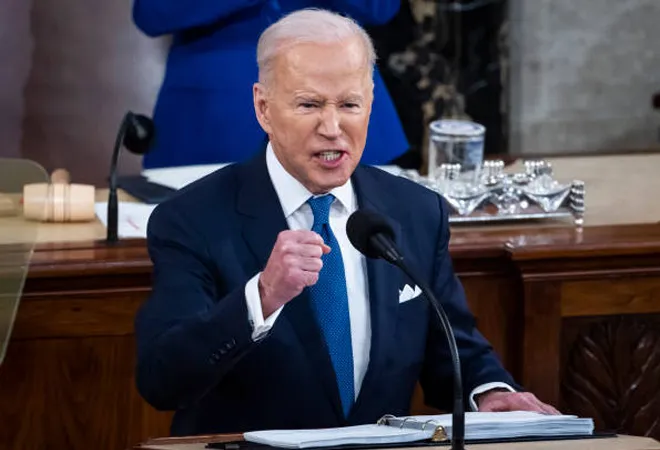-
CENTRES
Progammes & Centres
Location
Biden's State of the Union Address tilted more towards addressing US’ domestic issues as opposed to global issues such as the Ukrainian crisis and Afghanistan

The State of the Union (SOTU) address is an annual address by the US presidents to a joint session of the Congress. Typically, it is an opportunity for the US presidents to present their accomplishments, underscore challenges and priorities, as well as announce legislative proposals. On the downside, State of the Union addresses have often been derided in common perceptions as a presidential ‘to-do’ list. Perhaps, Biden exceeded the much-criticised perception with a strong pitch against Russian invasion of Ukraine and a reinforced domestic vision oriented towards lifting the US economy back on its legs. It remains to be seen how Biden’s announcements weigh against his political fortune in the midterm elections later this year.
On 2 March, Biden delivered the yearly State of the Union speech laying out before the Congress his report card over the past one year. Biden’s address began with a ‘strong’ pitch about the steps undertaken by the US government to deter Russia from its ongoing military actions against Ukraine. In his quintessential off-the-cuff style, Biden delivered his second State of the Union speech amidst rising uploads from the Democrats and Republicans. As is characteristic of most of the presidential State of the Unions, Biden’s speech was also parsed with representatives and beneficiaries of some of the policy imperatives that his administration has implemented or is willing to implement over the past year. Biden’s speech was also high on symbolism. Many lawmakers, including the First Lady, Jill Biden, were wearing yellow and blue in support of Ukraine.
Biden exceeded the much-criticised perception with a strong pitch against Russian invasion of Ukraine and a reinforced domestic vision oriented towards lifting the US economy back on its legs.
The timing of the speech, with the Ukrainian crisis in the background, had already forced several drafts of the speech. Biden’s pitch on Ukraine was crafted to project the Democratic efforts made by his administration that led to a domestic political unity back home and a strengthening of trans-Atlantic ties. However, this impressionistic attempt was also undergirded by a conviction that such efforts were strong enough measures against Russia, perhaps quite in dissonance with the geopolitics playing out in the Eurasian heartland.
Amongst the steps against Russia, Biden’s announcement of a US Department of Justice-led task force to go after Russian oligarchs and corrupt leaders was meant to depict strong actions against Putin’s close circle. Although the priority given to the Ukrainian crisis gave the impression that foreign policy has been a core concern for his administration over the past year; his quick turn to domestic issues for the rest of his speech underscored the fact that his administration’s domestic focus is going to overshadow America’s traditional foreign commitments. The US’ international constraints were conspicuous throughout Biden’s speech by their absence. To be sure, there were three main planks of his speech: The American support to Ukraine; focus on the economy back home; and dealing with the pandemic.
An important domestic pitch for Biden was concerning steps taken to address high inflation that the US currently faces—the highest in four decades. The political landscape of Biden has been influenced by the inflation and price rise. Most Americans, 7 on 10, now believe that inflation has not been dealt with in the best manner. Linking the direct correlation between the pandemic, inflation, and reliance on foreign supply chains, Biden pitched for ‘make in America’. However, there is scepticism and lack of clarity over how the boosting manufacturing at home could address inflation in the short term in the US.
Linking the direct correlation between the pandemic, inflation, and reliance on foreign supply chains, Biden pitched for ‘make in America’.
The address was also used by Biden to preemptively push back against some negative perception building against the Democrats, which could harm them in the midterm elections later this year. As per a leaked memo from the campaign of House Democrats, the Republicans are likely to target the Democrats on three critical issues: “wokeness”; porous border, and defunding the police. Biden devoted considerable attention to tackling the latter two in his speech. In this regard, he talked about the “Dreamers” and how America’s borders need fixing to address its immigration problem. His support for funding the police was meant to stave off any Republican opposition to defunding the police and co-opt an agenda that may not represent core democratic or bipartisan interest.
Surprisingly, Biden completely skipped the Afghanistan fiasco and an important leg office foreign policy. Despite the thumping note at the beginning of his speech, Biden could not move beyond Russia, which is an existential crisis for Ukraine in his foreign policy in his State of the Union Address. The fact that a devastating humanitarian crisis continues to impact Afghanistan along with US involvement in freezing the assets of Kabul, issues of foreign policy did not get the desired attention beyond Russia. On the domestic front, Biden championed the infrastructure initiatives that his government has launched under the “Build Back Better” programme. Other important areas of emphasis included the focus on lower drug prices and the international competitiveness for the US in the area of pharmaceutical products, specially medicines like insulin which are perhaps the most unaffordable in the US.
Within a year, Biden has been tested twice in unprecedented ways on his foreign policy, once in Afghanistan and second time in the ongoing Ukraine crisis. There is a sense that Biden could’ve underscored the trans-Atlantic ties more firmly in his speech, to balance between a reinforced domestic approach and a resolute outlook abroad. Through the language and the tenor, Biden also attempted to overcome some of the weariness that had beset his term owing to a mix of domestic political divisions and foreign policy compulsions.
The fact that a devastating humanitarian crisis continues to impact Afghanistan along with US involvement in freezing the assets of Kabul, issues of foreign policy did not get the desired attention beyond Russia.
The State of the Union is a widely watched address in the US. Most presidents look at it as a pitch to woo disgruntled voters back to their fold. For Biden too, whose approval ratings are considerably low and is staring at the upcoming midterm elections later this year, it was an opportunity to embolden his political fortunes. The unusual jump in his approval ratings to 47 percent post the SOTU may have given Biden political hope but a lot will depend on whether the upward trend holds for the next eight months. Critically, his speech is also being seen as having skipped the race question—quite in contrast to his SOTU address in 2021—despite Biden flagging his nomination of Ketanji Brown Jackson who could be the first black woman to sit on the Supreme Court in its history. Black voters formed an important component of Biden’s victory in the presidential race and in ensuring majority for the Democratic Party in both the House and the Senate. Their support in the midterm elections this year will be as critical for the Democratic Party. Finally, since the support for Biden’s handling of the Ukrainian crisis has soared post the SOTU, how the Ukrainian crisis ends, how effective are the current sanctions against Russia, and what a post-Ukraine world means for American leadership in the world remains to be seen. These open questions will continue to beset President Biden and the Democratic Party.
The views expressed above belong to the author(s). ORF research and analyses now available on Telegram! Click here to access our curated content — blogs, longforms and interviews.

Vivek Mishra is Deputy Director – Strategic Studies Programme at the Observer Research Foundation. His work focuses on US foreign policy, domestic politics in the US, ...
Read More +